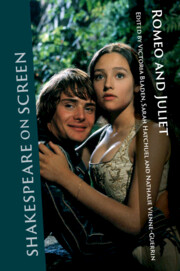Book contents
- Shakespeare on Screen: Romeo and Juliet
- Series page
- Shakespeare on Screen: Romeo and Juliet
- Copyright page
- Dedication
- Contents
- Figures
- Notes on Contributors
- Series Editors’ Preface
- Acknowledgements
- Chapter 1 Introduction – From Canon to Queer: Romeo and Juliet on Screen
- Part I Revisiting the Canon
- Part II Extending Genre
- Chapter 6 Romeo and Juliet and the Western
- Chapter 7 Pixarfication, Comedy and Earning the Happy Ending in Gnomeo & Juliet
- Chapter 8 Decentring the Hypotext with Denim and Zombies: Jonathan Levine’s Warm Bodies (2013) and David Lachapelle’s Romeo & Juliet (2005)
- Chapter 9 Guns, Rasa and Roses: Sanjay Leela Bhansali’s Ram-Leela (2013), a ‘Desi’ Romeo and Juliet
- Chapter 10 Indian Romeo and Juliets and Their Uncommonly Tragic Endings
- Part III Serial and Queer Romeo and Juliets
- Index
- References
Chapter 9 - Guns, Rasa and Roses: Sanjay Leela Bhansali’s Ram-Leela (2013), a ‘Desi’ Romeo and Juliet
from Part II - Extending Genre
Published online by Cambridge University Press: 10 October 2023
- Shakespeare on Screen: Romeo and Juliet
- Series page
- Shakespeare on Screen: Romeo and Juliet
- Copyright page
- Dedication
- Contents
- Figures
- Notes on Contributors
- Series Editors’ Preface
- Acknowledgements
- Chapter 1 Introduction – From Canon to Queer: Romeo and Juliet on Screen
- Part I Revisiting the Canon
- Part II Extending Genre
- Chapter 6 Romeo and Juliet and the Western
- Chapter 7 Pixarfication, Comedy and Earning the Happy Ending in Gnomeo & Juliet
- Chapter 8 Decentring the Hypotext with Denim and Zombies: Jonathan Levine’s Warm Bodies (2013) and David Lachapelle’s Romeo & Juliet (2005)
- Chapter 9 Guns, Rasa and Roses: Sanjay Leela Bhansali’s Ram-Leela (2013), a ‘Desi’ Romeo and Juliet
- Chapter 10 Indian Romeo and Juliets and Their Uncommonly Tragic Endings
- Part III Serial and Queer Romeo and Juliets
- Index
- References
Summary
This chapter analyses the film Ram-Leela using rasa theory, examining the dramatic ways in which the film evokes emotion – for example, through the use of colour, cinematography and music – and conveys meaning through direct and indirect references to Hindu mythological figures and narratives. Rasa theory, and its religious referents, are especially efficacious for approaching Ram-Leela as its title, which literally names the two main characters Ram (Romeo) and Leela (Juliet), is also the name of one of the most significant sacred celebrations in India’s Hindu calendar, Ramlila, an annual autumn festival during which plays are performed that present the life of the god Rama from his birth. Many scholars have discussed the key importance of the story of King Rama and his wife Sita in the narratives featured in Bollywood cinema. Ram-Leela plays with these conventions, participating vividly in the impassioned expression of emotion called for in rasa theory, performing far outside the boundaries of realism, whilst also departing in significant, telling ways from both the narrative of the Ramayana and that of Romeo and Juliet.
- Type
- Chapter
- Information
- Shakespeare on Screen: Romeo and Juliet , pp. 140 - 154Publisher: Cambridge University PressPrint publication year: 2023

